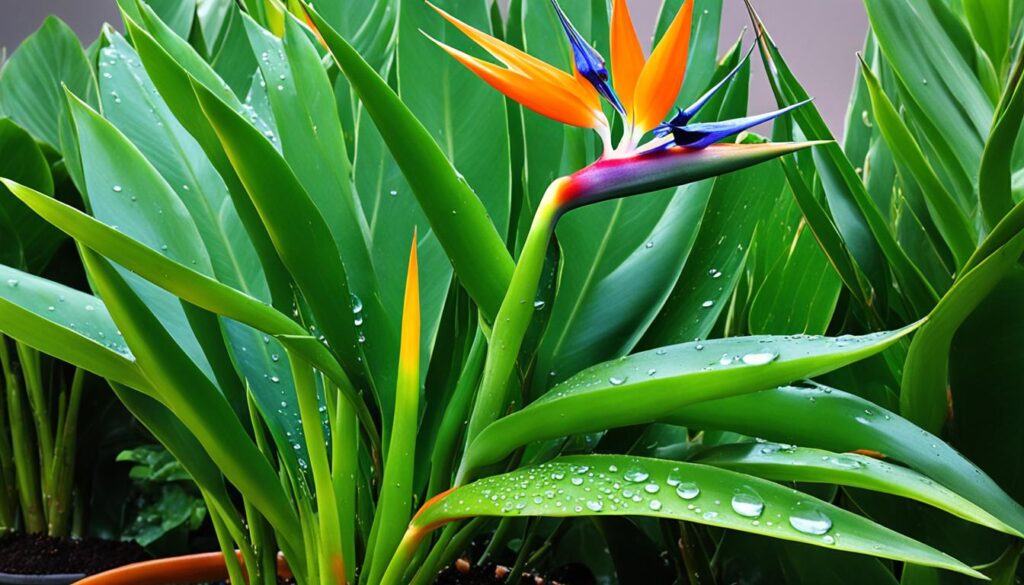The sun shone brightly through Sarah’s large bay window, lighting up the lush tropical plants. Among them, the Strelitzia reginae, or bird of paradise, caught her eye. Its vibrant orange and blue flowers looked like a bird in flight. Sarah loved having this plant in her indoor garden.
But, she soon learned that keeping the bird of paradise healthy was tricky. It was all about getting the watering just right.
Proper watering is key for bird of paradise plants, whether they’re inside or outside. They need consistent moisture but can be picky. Knowing the best way and how often to water them is crucial for their health and beauty.
Key Takeaways
- Bird of Paradise plants should be watered thoroughly when the top 2-3 inches of soil is dry, usually once a week.
- Regular watering is recommended to maintain the health of Bird of Paradise plants.
- Overwatering can lead to yellowing leaves, while underwatering may result in curling leaves and brown edges.
- Watering frequency may need to be adjusted based on factors like season, temperature, and soil type.
- Proper drainage and attention to your plant’s signals are key to a successful watering routine.
What is a Bird of Paradise Plant?
The Strelitzia reginae, also known as the bird of paradise, is a stunning tropical herbaceous plant from South Africa. It’s an evergreen that grows year after year and is part of the Strelitziaceae family. This family is close to the banana family (Musaceae).
Origin and Botanical Classification
This plant calls the coastal areas of South Africa home, where it loves the warm, humid weather. Its orange-blue flowers look like a bird flying, earning it its name. These flowers help the plant survive strong winds in its natural setting.
Distinguishing Features and Appearance
The bird of paradise plant stands out with its banana-like plants and big, split leaves. It can grow up to 20 feet tall in the wild but usually reaches 3 to 8 feet indoors. It’s adaptable, thriving in USDA hardiness zones 10a through 12b. This makes it a favorite for both indoor and outdoor spaces.
“The bird of paradise plant is a true showstopper, captivating with its exotic blooms and tropical foliage.”
Importance of Proper Watering for Bird of Paradise
Getting the right amount of water is key for the health and growth of bird of paradise plants. These plants need specific watering, whether they’re inside or outside. If you don’t water them enough or too much, they can suffer. This can cause slow growth, or even make their leaves turn color and droop.
To keep your bird of paradise healthy, knowing how often and how to water is crucial. In the winter (October – February), when it’s not sunny, water them less. But in spring and summer, when they grow fast, you should water them more.
Make sure the top 2-3 inches of soil dry out before you water again. This stops root rot, a problem from too much water. Proper watering keeps the plant healthy and helps it grow well.
“Consistent moisture, but not waterlogged soil, is key for the health and growth of bird of paradise plants.”
The amount of water your plant needs changes with its size, age, and the season. Young or new plants might need water every day. But bigger, older plants can wait longer between waterings. It’s important to adjust how often you water based on your plant’s growth and where it is.
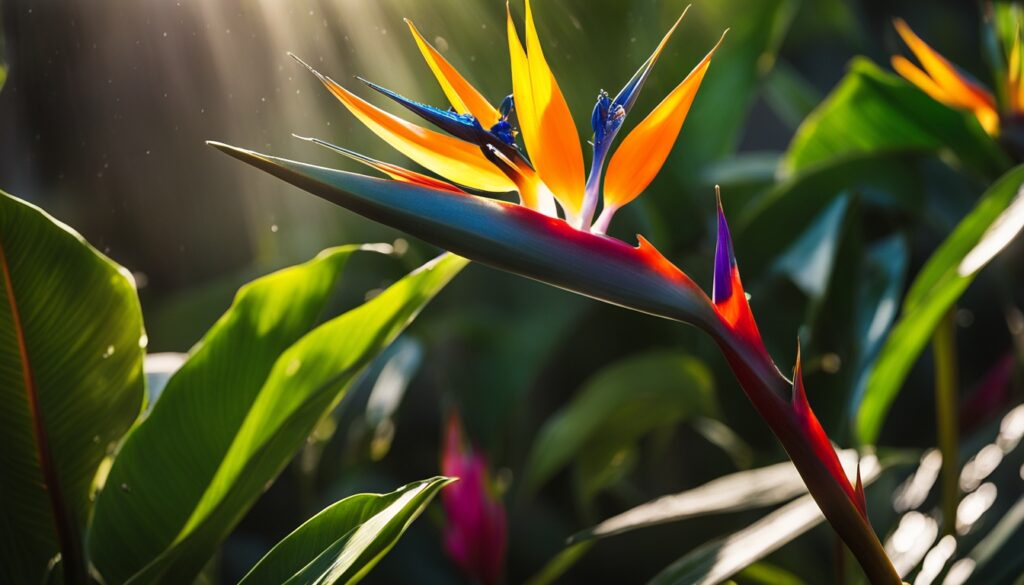
Understanding and meeting your bird of paradise’s water needs helps keep it looking lush and healthy. This way, it will keep doing well in your home or garden.
How often to water birds of paradise?
Watering your bird of paradise plant is key to keeping it healthy. You should water it every 1-2 weeks, letting the soil dry out a bit between. But, the right watering schedule depends on many environmental factors.
Factors Affecting Watering Frequency
The size of the plant, the pot, the sunlight it gets, and the environmental conditions matter. Big plants in small pots need more water than small ones in big pots. Plants in the sun dry out faster and need more water than those in the shade.
Signs of Overwatering and Underwatering
- Too much water can cause yellowing or drooping leaves, and even root rot.
- Not enough water leads to wilting, curling, and drying of the foliage.
Keep an eye on the soil moisture and adjust watering to keep your plant healthy. This helps avoid leaf issues.
“Strelitzias typically flower in late winter and spring, so it’s important to keep the soil moist from April to September, then reduce watering gradually in autumn and winter.”
Knowing how often to water your bird of paradise and what affects it will help it bloom beautifully.
Ideal Soil Conditions for Bird of Paradise
Getting the soil right is key for bird of paradise plants to grow well. These tropical plants do best in potting mixes that drain well and keep moisture and air in. Mixing standard potting soil with perlite, or lava rocks helps with drainage and stops water from pooling.
It’s important to meet the soil requirements to prevent root rot from happening. This can happen if the soil stays too wet. A well-draining mix lets roots get the air they need and keeps the plant moist but not soggy.
Well-Draining Potting Mix
Choose a potting mix made for well-draining and aerated conditions for your bird of paradise. These mixes usually have peat moss, bark, perlite, and vermiculite for the best soil setup.
- Peat moss keeps moisture in but lets water drain well.
- Perlite and lava rocks help with aeration and stop the soil from getting too dense.
- Bark or other organic bits add nutrients and make the soil better.
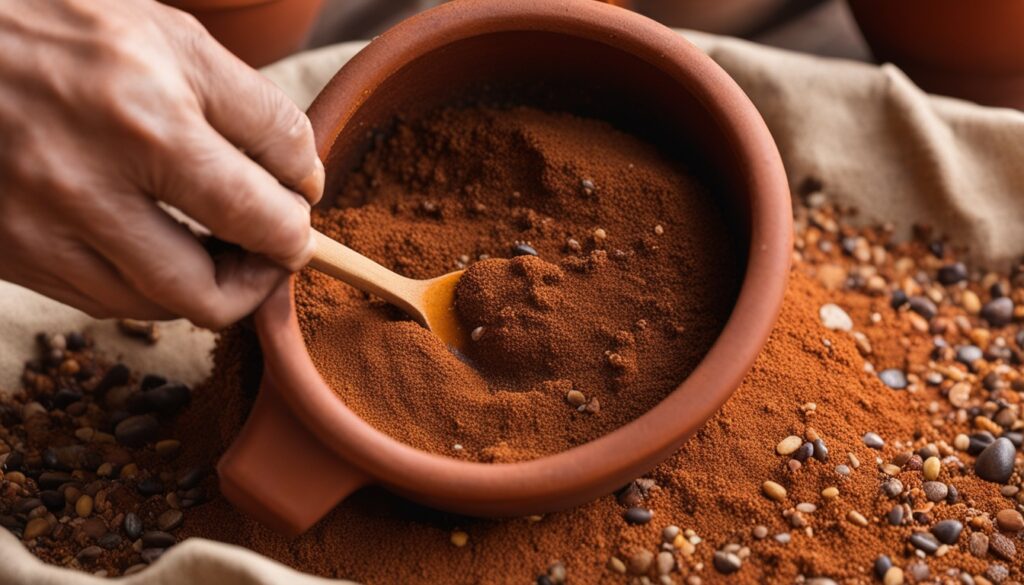
“The right soil conditions are crucial for the long-term health and success of bird of paradise plants.”
Light Requirements for Optimal Growth
Bird of paradise plants love bright, indirect light to full sun. They may drop leaves in low light. Place your plant 3 feet from a south-facing window for enough sunlight.
Good lighting is key for your bird of paradise’s health and flowers. These plants need at least 6 hours of bright indirect light daily. They can handle full sun for part of the day too. Putting your plant in a sunny spot helps it grow well.
“Bird of paradise plants are true sun-lovers and will reward you with lush foliage and stunning blooms when given the right amount of light.”
If your bird of paradise’s leaves droop or turn color, it might not get enough sun. Move the plant to a sunnier spot to meet its sunlight needs.
Getting the right mix of bright indirect light and direct sun exposure is crucial. With the right light, your bird of paradise will stay healthy and might even bloom beautifully.
Humidity Levels for Bird of Paradise
Keeping the right humidity is key for your Bird of Paradise plant’s health and look. These plants love a humid environment with levels between 60-70%. If your home is dry, adding moisture with misting or a humidifier can stop leaves from getting brown and crispy.
Misting and Humidifier Use
To keep your Bird of Paradise happy, try these tips:
- Use a hygrometer to check the humidity. Keep it between 60-70%.
- Mist the leaves with water to add moisture quickly. But, misting might not be enough by itself.
- Get a good humidifier to keep the air moist around your plant. Put it near the plant for best results.
- Use a fan on low to improve air flow. This helps spread moisture evenly and stops damp spots that can cause mold or pests.
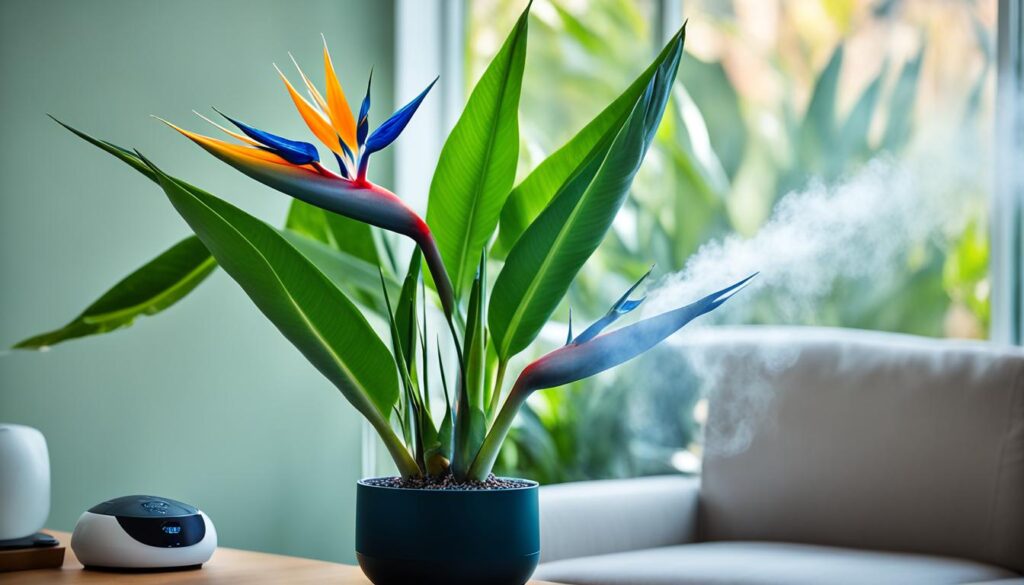
By watching and adjusting the humidity, you can make the best home for your Bird of Paradise. This ensures its lush leaves and bright flowers.
Temperature Preferences
Bird of paradise plants love a certain temperature range to stay lush and tropical. They do best in temperatures between 65°F and 85°F (18°C to 30°C). But, they can handle as low as 24°F (-40°C) without much cold damage.
It’s important to keep these plants away from drafts and big temperature changes. Temperatures under 60°F (15°C) can hurt their health. This can lead to leaf discoloration, wilting, and even losing leaves.
“Bird of paradise plants prefer a warm, humid environment to thrive. Maintaining the optimal temperature range is essential for their lush growth and vibrant appearance.”
To give these plants the best chance, place them where it’s warm and steady. Keep them away from cold drafts and sudden temperature drops. Checking the temperature and making changes as needed will help them grow well.
Common Problems and Solutions
Bird of paradise plants are usually easy to care for. But, they can face problems like pests and leaf issues. It’s important to watch for these issues and fix them quickly to keep your plant healthy and looking great.
Pest Infestations
Spider mites are a common pest for bird of paradise plants. These tiny bugs can make leaves look bad and stop them from growing well. To fight spider mites, you can use neem oil. It kills the pests without hurting the plant.
Leaf Discoloration and Drooping
Leaf problems like discoloration and drooping can mean you’re watering too much or too little. Keep an eye on the soil’s moisture and adjust your watering. Let the top 2 inches of soil dry out before you water again to avoid these issues.
- Too much water can turn leaves yellow and cause root rot. Make sure the soil drains well and isn’t too wet.
- Not enough water can make leaves turn brown and curl. Give your plant enough water, especially when it’s hot or dry.
By solving these common problems and caring for your plant right, your bird of paradise will stay beautiful and healthy. It will be a great part of your garden or indoor space.
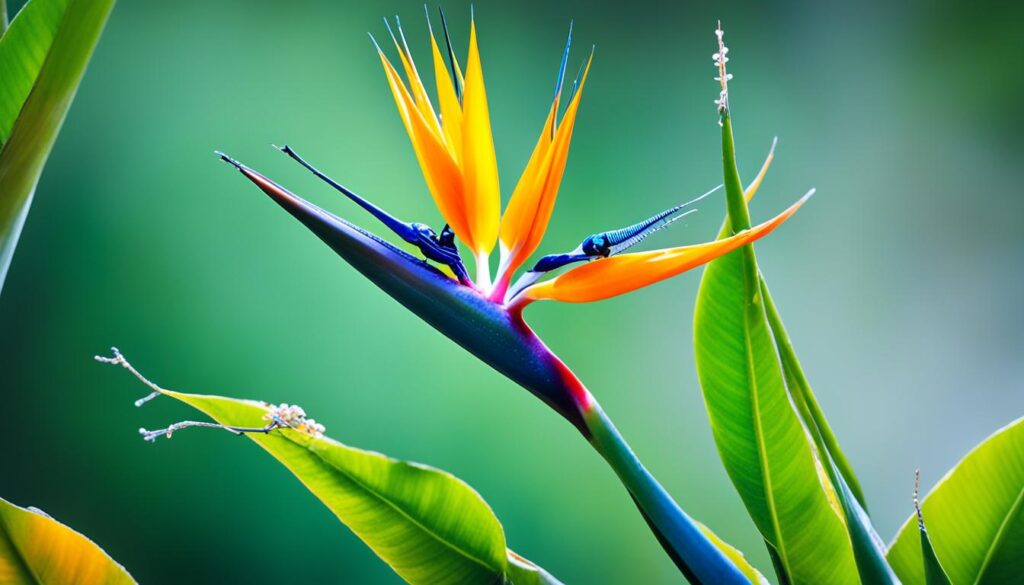
“Proper cultural conditions and sanitization practices help prevent the spread of diseases in Bird of Paradise plants.”
Fertilizing Bird of Paradise Plants
Bird of paradise plants need a lot of food and do well with regular fertilizers, especially when they’re growing. Use a gentle, balanced houseplant fertilizer every month to give them the nutrients they need. When the plant gets bigger, think about repotting it every year or when it’s doubled in size. This makes sure it gets enough nutrients for growth and health.
For the best growth, bird of paradise plants love a balanced fertilizer with equal parts nitrogen, phosphorus, and potassium (1:1:1). Adding a 2 to 3 inch deep layer of mulch is also good for these plants. It keeps the soil moist and slowly adds nutrients to the soil.
- Strelitzia Reginae plants do well with top dressings of manure or blood meal outside. They should get granular landscape fertilizers every three months when they’re growing.
- Indoor Strelitzia Reginae plants should get fertilized every two weeks when they’re growing and once a month when they’re not.
- Mandela’s Gold variety of bird of paradise plants need feeding every two weeks when they’re growing. They should also get watered-in fertilizer once a month in the summer.
- Strelitzia Nicolai, the tree-size bird of paradise, gets a top dressing of manure. Young plants should be fertilized once a month when they’re growing.
By following these fertilizing tips and knowing what different bird of paradise plants need, gardeners can make sure their plants get the right nutrients. This leads to lush, healthy growth and beautiful flowers.
Pruning and Maintenance
Keeping your bird of paradise plant in top shape requires proper pruning and maintenance. The plant’s split or torn leaves help it survive strong winds. But, you can trim away any leaves that are badly damaged or look bad. Cleaning the leaves with a damp cloth can also keep the plant looking good and healthy.
Prune your bird of paradise plant in early spring for major trimming. The blooms last about 2 to 3 weeks before they fall off. This is when you can start pruning. Cut all leaves and stems back to just above the ground. Pruning helps increase flowers and prevents fungal diseases by letting air and light into the plant.
- Never remove more than one-third of the plant material per season when thinning a bird of paradise.
- Pruning should be done at the end of winter to encourage robust spring growth.
- Removal of spent flowers is recommended, followed by damaged leaves if over 50% gone, and crowded offshoots.
- Avoid over-pruning by removing only one-third of the plant material at a time.
For pruning, use pruning shears, loppers for thick branches, and trimming snips for small spots. Deadheading, or removing spent flowers, helps the plant focus on new growth. If the plant is too crowded, consider dividing it to give it more room to grow.
“Pruning stimulates growth and flowering in plants, but it’s important to avoid removing more than 25% of the plant during pruning to prevent stress.”
Regular care like watering, fertilizing, and checking for pests is key to your bird of paradise plant’s health and looks. By following these tips on pruning and care, your plant will stay beautiful for many years.
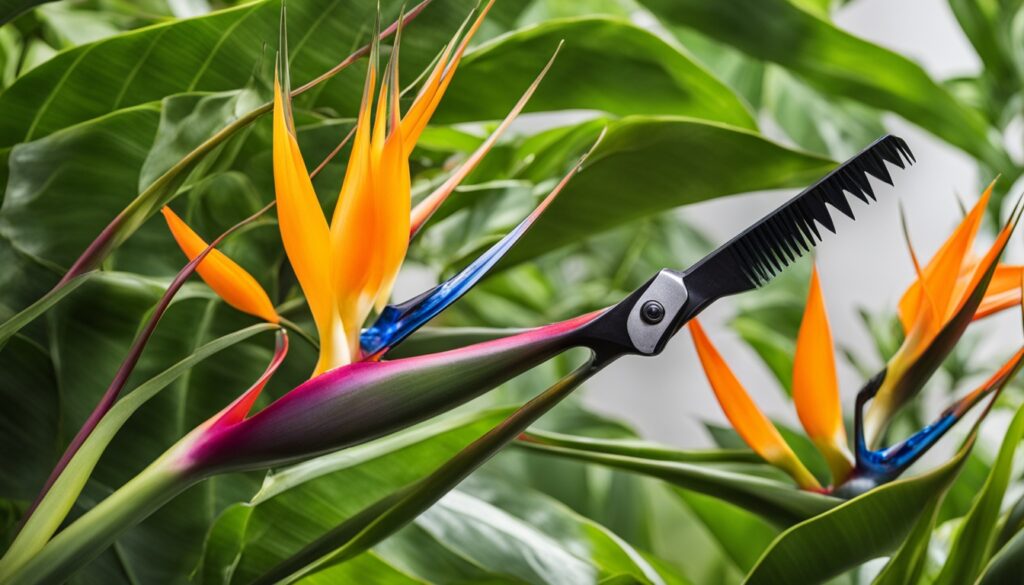
Indoor vs. Outdoor Growing
Bird of paradise plants can grow well inside or outside, but they have different needs. Knowing what they need indoors and outdoors is key for their health and beauty.
USDA Hardiness Zones
For outdoor growth, the USDA hardiness zone matters a lot. These plants do best in USDA hardiness zones 10a to 12b. This means they like places where it’s always over 50°F (10°C).
Inside, the temperature is important for these plants. They love warm, steady temperatures, between 65°F and 85°F (18°C and 29°C). They don’t like cold drafts or sudden changes in temperature.
“Properly acclimating the plant when transitioning between indoor and outdoor environments is essential for its overall health and growth.”
Whether inside or outside, these plants need the right light and humidity. With proper care, they can thrive in many places, adding tropical beauty to any area.
Propagation Methods for Bird of Paradise
Bird of paradise plants stand out with their vibrant leaves and flowers that look like a bird flying. Growing them from seed is possible but slow and hard. For a faster and more reliable way, division is the top choice.
Division Propagation
Division means cutting the plant’s underground stem, called the rhizome, into smaller parts. Each part gets its own roots. This is done when you’re repotting or when stems grow too close together. Careful division makes sure each new plant can grow well on its own.
The best time for division is in spring, when the plant is growing fast. You can divide a bird of paradise plant every 3-5 years to keep it healthy. Use a sharp, clean tool to cut the rhizome, making sure each piece has roots, a leaf, and part of the root system.
After dividing, put the new plants in a pot with good drainage and lots of nutrients. With the right care, these plants will quickly grow and start flowering.
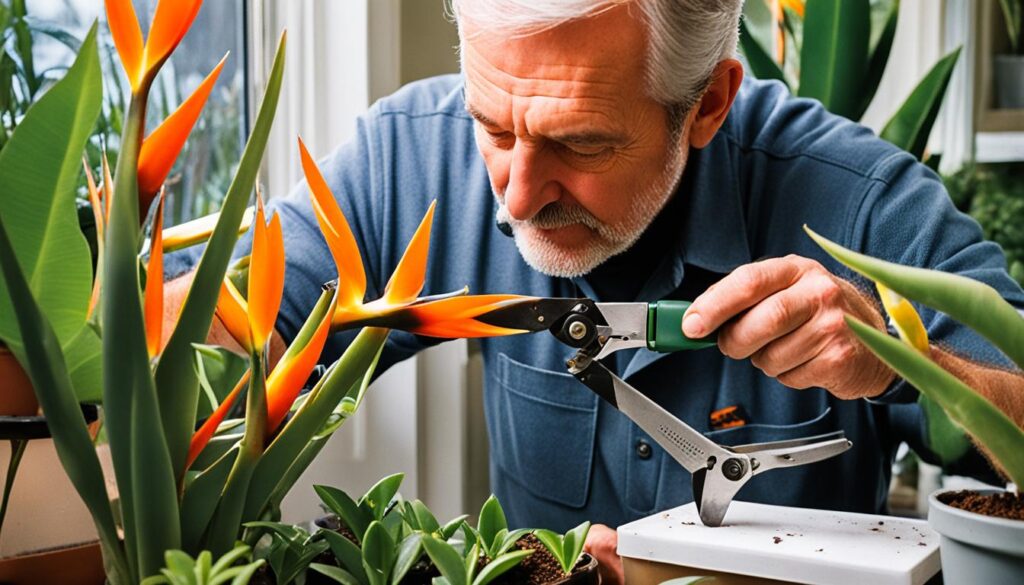
“Propagation by division is the most common and reliable method for multiplying bird of paradise plants.”
Toxicity Concerns and Pet Safety
The Bird of Paradise plant is a stunning choice for your home. But, it’s important to know about its potential dangers, especially for pets and kids. This plant has compounds that can irritate if eaten.
Pets like dogs and cats might want to taste the plant’s bright flowers or leaves. Eating the Bird of Paradise can cause vomiting, diarrhea, and trouble moving around. In worse cases, pets could have shaking, seizures, or even pass out.
- Dogs may breathe fast, drool a lot, and get dehydrated from the plant’s seeds and flowers.
- Cats might feel sick, dizzy, and have stomach problems after eating the Bird of Paradise.
If you think your pet ate the Bird of Paradise, call a vet or a pet poison hotline right away. Quick action, like making them vomit, giving activated charcoal, and supportive care, can help prevent serious problems.
To keep your pets safe, keep the Bird of Paradise away from them. Choose safe plants for your home instead. This way, you can still enjoy the plant’s beauty without risking your pets’ health.
“The safety of our pets should always be the top priority when bringing new plants into the home.”
Conclusion
Proper care is key for the health and growth of bird of paradise plants. By following the right watering, lighting, and environmental tips, you can grow these plants well indoors or outdoors. They can bring stunning, bird-like flowers that add elegance to any space.
Keeping up with the bird of paradise plant’s needs is important for its beauty and health. By meeting its specific needs, gardeners can help these plants thrive. This ensures they reach their full beauty and potential.
If you love plants or are just starting, this article can help you care for your bird of paradise plants. With the right watering, soil, and light, you can make these tropical plants shine. They can turn your indoor or outdoor areas into lush, exotic spots with beautiful flowers.
FAQ
How often should I water a bird of paradise plant?
Water your bird of paradise plant every 1-2 weeks. Let the soil dry out a bit between waterings. The exact frequency depends on the plant’s size, pot size, sunlight, and environment.
What is a bird of paradise plant?
The Strelitzia reginae, or bird of paradise, is a tropical plant from South Africa. It looks like a banana plant and has bright orange-blue flowers that look like a bird in flight.
Why is proper watering important for bird of paradise plants?
Proper watering is key for the health and growth of bird of paradise plants. Too little or too much water can cause problems like stunted growth or leaf discoloration.
What factors affect the watering frequency for bird of paradise plants?
The watering frequency depends on the plant’s size, pot size, sunlight, and environment.
What are the signs of overwatering and underwatering for bird of paradise plants?
Overwatering can cause yellowing or drooping leaves. Underwatering leads to wilting, curling, and drying of the leaves.
What type of soil do bird of paradise plants prefer?
These plants do well in well-draining potting mixes. Use a mix of standard potting soil, perlite, or lava rocks to improve drainage and prevent waterlogging.
How much light do bird of paradise plants need?
They need bright, indirect light to full sun for best growth. They struggle and may drop leaves in low light.
What humidity levels do bird of paradise plants prefer?
They like high humidity, around 50-60%. Adding humidity with misting or a humidifier can prevent leaf edges from turning brown.
What temperature range is ideal for bird of paradise plants?
The ideal temperature is between 65°F and 85°F (18°C to 30°C). Keep them away from cold drafts and sudden temperature changes.
What are some common problems and solutions for bird of paradise plants?
Common issues include pests like spider mites and leaf problems from too much or too little water. Address these quickly with pest control and watering adjustments.
How do I fertilize and maintain a bird of paradise plant?
These plants need regular fertilizing during the growing season. Repot them yearly or when they outgrow their pot. Pruning and cleaning leaves also helps keep them healthy.
Can bird of paradise plants be grown indoors and outdoors?
Yes, they can be grown indoors or outdoors, depending on your climate and hardiness zone. Indoors, they need bright light and consistent temperature and humidity. Outdoors, they thrive in zones 10a through 12b.
How do I propagate a bird of paradise plant?
You can propagate them through division. Separate the plant into sections with roots when repotting or when they grow together.
Are bird of paradise plants toxic?
Yes, they have compounds that can irritate pets or young children. Keep them away from reach and watch for any signs of exposure or ingestion.
